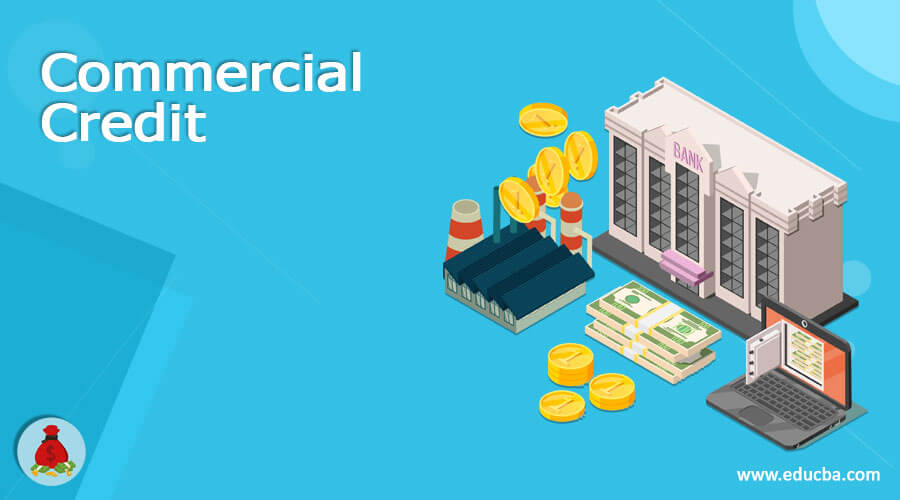Updated July 13, 2023

What is Commercial Credit?
The term “commercial credit” refers to the pre-approved credit line issued by the bank or other similar financial institution to a company. The borrower usually avails the credit line at any time for meeting short-term financial shortfalls, such as working capital requirements.
Commercial credit can be considered a revolving line of credit. Thus, it is often drawn for funding day-to-day business requirements and paid back as soon as funds become available. This credit facility is also commonly referred to as “business credit” or “commercial line of credit”.
How to get Commercial Credit?
One needs to follow a few steps before applying for commercial credit at a bank, credit union, or other financial institution. The steps are as follows:
Step 1: Firstly, check the credit report of the subject company. It is a very important step because the information in the credit report eventually goes into the credit score. So, one needs to ensure that everything is reported correctly. In case of any dispute, flag and raise the issue immediately to the concerned authority.
Step 2: When done with checking the credit report, apply for the commercial credit facility at a bank. Once approved, the bank will grant a specific amount for a particular draw period, which can vary and may last up to several years.
Step 3: Once the credit facility is ready for withdrawal, the bank may issue a card or check. In some cases, the bank may even choose to transfer the fund to the subject company’s checking account.
Types of Commercial Credit
In general, there are two broad types of commercial credit that are primarily revolving in nature. They are as follows:
1. Secured Commercial Credit
As the name suggests, this type of credit facility is secured by collateral. If the debtor company defaults or is unable to pay a significant part of the borrowed funds, then the creditor or bank has the right to seize the collateral, sell it off in the market, and use the proceeds to settle the outstanding debt. Given the lower risk of the lender, it is easy to get secured commercial credit and is available at a relatively lower interest rate.
2. Unsecured Commercial Credit
Unlike secured commercial credit, this type of credit facility isn’t backed by any collateral. Thus, unsecured commercial credit is usually offered at a higher interest rate and with a lower borrowing limit as the lender assumes the risk of default. Also, the evaluation process, in this case, is very strict and thorough.
Example
Now, let us look at a simple example to understand the practical use of commercial credit.
Let us assume that ABC Inc. is a dealer of new cars. Now, during the festive season, the company expects a higher volume of sales, for which it needs to maintain a higher inventory of vehicles. The additional inventory requirement is $25 million. Currently, the company has a cash balance of only $10 million, and it has no other assets or marketable securities available to liquidate to raise the remaining money.
Luckily, three months back, the company obtained a $20 million commercial credit line with ASBC Bank, and it is yet to avail that credit line. Thus, the entire $20 million is available for use, and it can resolve the funding shortfall. So, ABC Inc. can access it to get the required funds immediately.
Advantages
Some of the major advantages are as follows:
- It helps companies overcome cash requirements in the short term. This provides peace of mind to the managers as the credit facility ensures that day-to-day operations won’t be disrupted due to cash shortfall.
- The interest rates are fixed for a particular draw period, which means that the company doesn’t need to resort to high-interest loans in case of any emergency.
- The credit facility can be leveraged to seize short-term business opportunities, such as the limited period discount sale of raw material that can be used to boost profitability.
- Consistent withdrawal and payment of borrowed funds, timely interest payment helps companies maintain a higher credit rating, which can be helpful in availing of the higher credit limit in the future.
Disadvantages
Some of the major disadvantages are as follows:
- In some cases, companies become complacent and start believing that the credit line would protect them against any financial obligations. In turn, they lose control of their operating expenses, which increases the risk of lower profitability.
- If the payments are not done in a timely manner, then the burden of principal and interest can further impact the profit margins.
- Delay in payment can also result in deterioration of the credit rating, which would eventually increase the cost of capital in the future.
Key Takeaways
Some of the key takeaways of the article are:
- They are pre-approved on-demand credit facilities offered by banks and other financial institutions to companies.
- One of the primary uses of these facilities is to fund day-to-day operations. Besides, these credit facilities are used to meet short-term financial obligations.
- The interest rates are decided for a particular draw period at the time of approval. The interest rates of unsecured commercial credit are usually higher than that of secured commercial credit.
Conclusion
So, it can be seen that commercial credit is a benefit extended by banks to companies. However, it can be advantageous if used with caution. Given that the fund is not interest-free, it should be used only in case of urgent requirements. Overall, it ensures that companies’ operations are not disrupted due to any sudden liquidity shortfall.
Recommended Articles
This is a guide to Commercial Credit. Here we also discuss the definition, types, examples, and How to get Commercial Credit along with its advantages and disadvantages. You may also have a look at the following articles to learn more –

